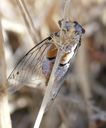Tacuini
Tacuini
Classification
- Phylum: Arthropoda
- Subphylum: Hexapoda
- Class: Insecta
- Order: Hemiptera
- Suborder: Auchenorrhyncha
- Infraorder: Cicadomorpha
- Superfamily: Cicadoidea
- Family: Cicadidae
- Subfamily: Cicadinae
- Tribe: Tacuini
Pronunciation
How to pronounce Tacuini: /tɑːˈkuːniː/
These audio files are automatically generated. While they are not always 100% accurate, they are a good starting point.
Images






Summary
Cicadas are large, loud insects known for their unique acoustic signaling and life cycles that can span years. The Tacuini tribe represents a specific group within the diverse family Cicadidae, which includes many genera and species across the globe.
Physical Characteristics
Cicadas are large insects characterized by their membranous wings, a triangular formation of three ocelli on the top of their heads, and short, bristle-like antennae.
Identification Tips
Look for the distinct and loud songs made by males, which vary by species. The anatomy, including the structure of the tymbals, can help in identification.
Habitat
Cicadas are typically found in wooded areas and urban environments, as they require trees for their life cycle and reproduction.
Distribution
Cicadidae exhibits a worldwide distribution with more than 3,200 species present in diverse habitats across all continents except for Antarctica.
Diet
Cicadas primarily feed on xylem fluid from trees and shrubs using their specialized mouthparts.
Life Cycle
Cicadas have an annual or periodical life cycle, remaining as nymphs underground for several years before emerging to mate as adults.
Reproduction
Cicadas reproduce by mating, where males call to attract females, who respond with wing clicks. After mating, females lay eggs in tree bark.
Predators
Natural predators of cicadas include birds, small mammals, and various insects that feed on them as adults or nymphs.
Ecosystem Role
Cicadas play a vital role in ecosystems as herbivores by feeding on plant sap and as prey for various predators, contributing to food webs.
Cultural Significance
Cicadas have cultural significance in many regions; they are often associated with summertime and are subjects of folklore and art.
Collecting Methods
- Netting
- Hand collecting
Preservation Methods
- Pinning
- Freezing
- Drying
Evolution
Cicadas are ancient insects, with fossils predating most modern species dating back to the Jurassic period. They have undergone significant evolutionary changes, particularly in their acoustic communication methods.
Similar Taxa
- Tettigarctidae
- Auchenorrhyncha
Misconceptions
Many people believe cicadas are harmful to plants, but they do not cause significant damage and primarily feed on sap.
Tags
- cicadas
- Tacuini
- Cicadidae
- insects
- entomology